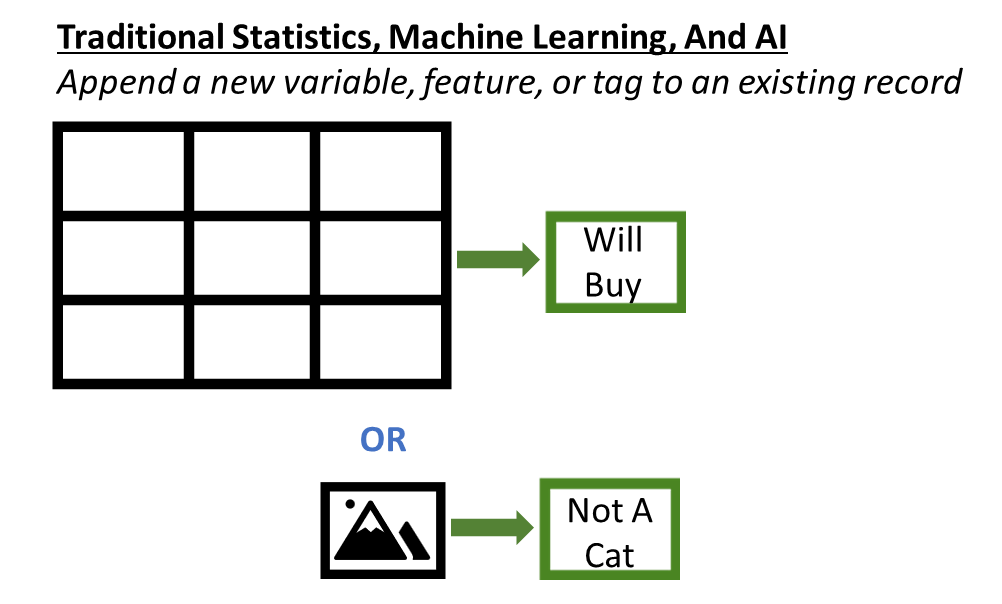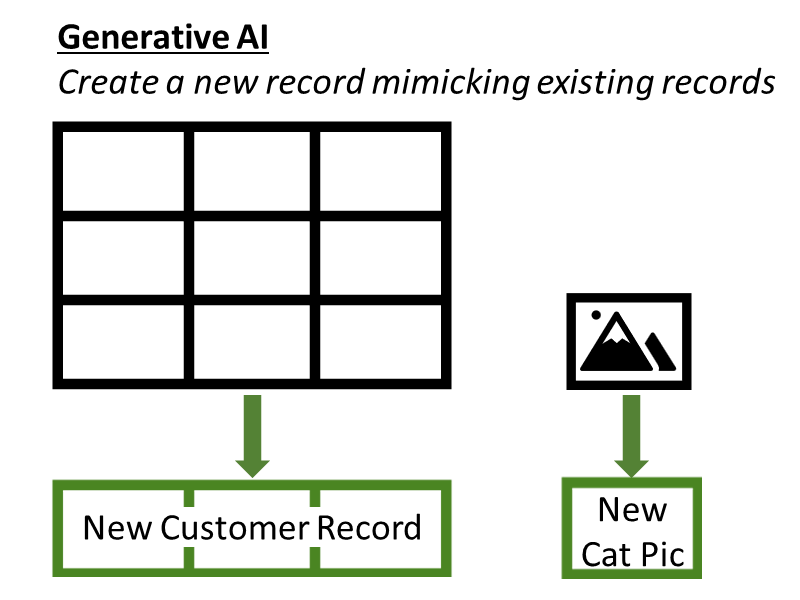While AI was a major trend for several years, the explosion of excitement and adoption that has occurred in the past year since the broadscale introduction of generative AI took it up several notches. It is like nothing since at least the big data boom of just over a decade ago. As with big data, however, many people are not understanding the fundamental value proposition of generative AI compared to the other algorithms in use today. By understanding what makes generative AI different, it is possible to better gauge its potential and to appreciate why there is so much hype surrounding it. This blog will explain.
What Traditional Models On Traditional Data Fundamentally Do
To start, let’s review what virtually every classic statistical modeling algorithm generates. When using traditional structured data, statistical models use the existing records to determine best how to predict, forecast, or classify each record. In effect, the models generate a new variable or feature for each record (see figure 1). That new variable or feature contains a prediction, forecast, or classification. For example, a response model appends a probability of response to each record. A forecasting model appends a forecast. A segmentation model appends a segment label.
For many years, tremendous value was derived from such models. While the breadth of modeling approaches continued to expand over time, all of them still fundamentally create a new variable or feature for each record.

Why Big Data Was Misunderstood
I have always felt that “big data” was a misleading term. Sure, most big data sources were in fact very big. However, as I wrote about in my first book Taming The Big Data Tidal Wave, it wasn’t really the “bigness” of big data that made it so valuable but the “differentness”. In other words, we didn’t simply have a bigger volume of the same old transactional or financial data. Rather, we had whole new types of data such as sensor data, web browsing data, and more. We also had, for the first time, the ability to store, process, and analyze unstructured data such as images, audio, and text.
Big data went big (pun intended) because all of those new data sources enabled businesses to address entirely new problems that previously were not previously addressable. Having the different data available took the power of analytics up a notch and this is what drove the big data era.
The Early Days Of Machine Learning And AI
When machine learning models and artificial intelligence models first hit the scene in a significant way, they were used in the same way as classic models – to predict, forecast, or classify. Neural networks became another go-to approach for predictive modeling, as an example, but they were initially still being used largely against structured data sources to make predictions.
As artificial intelligence came to prominence over the last 5 – 7 years, there was a lot of excitement. Huge advances were made in the analysis of text, images, audio, and more. However, even though there was a lot of hype and excitement about early AI work, it was still largely being applied just like classic models – albeit to different data types. AI models were used to predict/classify if an image was a cat (or not a cat) or if a text comment had positive (or negative) sentiment (see figure 1). In other words, most of the AI work getting attention until recently was still adding an additional tag or feature to an image or text input. Valuable, and worthy of excitement, but not causing the explosion of activity seen with generative AI.
What Really Makes Generative AI Unique
Tying the prior threads together allows us to see what makes generative AI so powerful and why the market has exploded. Big data and traditional artificial intelligence allowed totally new and different types of data to be used for prediction, forecasting, and classification. This, in turn, enabled many new business problems to be addressed. Generative AI does something very different and novel as well, however. Instead of appending a new variable, feature, or tag to an existing example, generative AI generates a new example that mimics the properties of the underlying training data as it relates to the prompt provided (see figure 2).

The ability to ask for a never-before-seen image or a from-scratch summary of a book is something that generative AI does that no other past approach, including the traditional uses of AI, made possible. As such, just like big data, generative AI opens a whole new range of business problems that can be addressed that were not previously addressable. This is the real reason why generative AI has exploded so fast and so broadly.
The world is still figuring out all of the ways that using generative AI to create new examples can be of use, and we can expect the discovery process to take quite some time. After all, generative AI is doing something fundamentally and conceptually different than any of the other analytics approaches of the past. That’s its fundamental value proposition.
Originally posted in the Analytics Matters newsletter on LinkedIn
The post Often Misunderstood: Generative AI’s Value Proposition appeared first on Datafloq.

